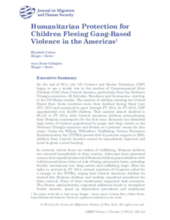EXECUTIVE SUMMARY
By the end of 2011, the US Customs and Border Protection (CBP) began to see a steady rise in the number of Unaccompanied Alien Children (UAC) from Central America, particularly from the Northern Triangle countries—El Salvador, Honduras and Guatemala—arriving to the US-Mexico border. The number of children entering the United States from these countries more than doubled during fiscal year (FY) 2012 and continued to grow through FY 2014. In FY 2013, CBP apprehended over 35,000 children. That number almost doubled to 66,127 in FY 2014, with Central American children outnumbering their Mexican counterparts for the first time. Research has identified high levels of violence perpetrated by gangs and drug cartels in the Northern Triangle countries and Mexico as a primary reason for this surge. Under the William Wilberforce Trafficking Victims Protection Reauthorization Act (TVPRA) passed with bi-partisan support in 2008, children from Central America cannot be immediately deported and must be given a court hearing.
In contrast, unless there are indicia of trafficking, Mexican children are returned immediately to their country. Advocates have expressed concern that expedited removal of Mexican children places children with valid humanitarian claims at risk of being returned to harm, including forcible recruitment into drug cartels and trafficking rings. After the spike in arrivals in FY 2014, several members of Congress called for a change in the TVPRA, urging that Central American children be treated like Mexican children and undergo expedited procedures for their removal. Many of their constituents supported such measures. The Obama administration requested additional funds to strengthen border security, speed up deportation procedures and implement measures to address the humanitarian crisis in Central America. Groups and individuals across the country came together to provide shelter, medical and psychological care and legal representation to many of these children. Despite these efforts, much needs to be done to ensure that their rights are protected.
This paper provides an overview of the violence perpetrated by gangs and other criminal organizations which compels many children to flee their communities. It describes the US government’s obligations to protect UAC upon arrival, and good practices of other governments relating to the protection of child migrants and refugees. It also discusses Special Immigrant Juvenile Status, gang-related asylum case law, and the difficulty of prevailing in asylum claims based on persecution by gangs. It concludes with recommendations to the administration and policymakers to ensure compliance with US obligations under national and international laws.

